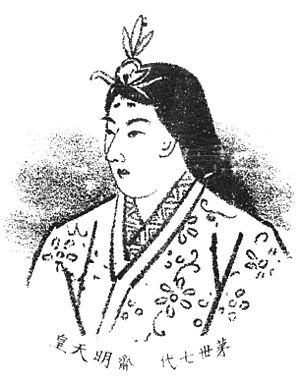Empress Kōgyoku facts for kids
Quick facts for kids Empress Kōgyoku / Empress Saimei皇極天皇 / 斉明天皇 |
|||||
|---|---|---|---|---|---|
 |
|||||
| Empress of Japan (Kōgyoku, first reign) |
|||||
| Reign | January 25, 642 – June 14, 645 | ||||
| Predecessor | Jomei | ||||
| Successor | Kōtoku | ||||
| (Saimei, second reign) | |||||
| Reign | January 3, 655 – July 24, 661 | ||||
| Predecessor | Kōtoku | ||||
| Successor | Tenji | ||||
| Empress consort of Japan | |||||
| Tenure | 630 – 641 | ||||
| Born | Takara (宝) 7 August 594 Japan |
||||
| Died | 24 August 661 (aged 66–67) Asakura no Miya |
||||
| Burial | Ochi-no-Okanoe no misasagi (Nara) | ||||
| Spouse | Emperor Jomei | ||||
| Issue |
|
||||
|
|||||
| Father | Prince Chinu | ||||
| Mother | Princess Kibitsu-hime | ||||
Empress Kōgyoku (皇極天皇, Kōgyoku-tennō, 594–661), also known as Empress Saimei (斉明天皇, Saimei-tennō), was a powerful ruler in ancient Japan. She was the 35th and 37th monarch of Japan. This means she ruled twice!
Her first time ruling was as Empress Kōgyoku, from 642 to 645. She stepped down after a big event called the Isshi Incident. This was when Soga no Iruka, a powerful leader, was killed. She then gave the throne to her brother, who became Emperor Kōtoku.
After Emperor Kōtoku died in 654, the throne was empty. So, in 655, she became empress again, this time as Empress Saimei. She ruled until her death in 661. This makes her one of the few rulers in Japanese history to have two separate reigns.
In the long history of Japan, Kōgyoku/Saimei was the second of only eight women to become an empress regnant. An empress regnant is a female ruler who holds full power, not just a wife of an emperor. The first female ruler was Suiko-tennō.
Contents
Empress Kōgyoku's Early Life and First Reign
Before she became empress, her personal name was Takara. As empress, her full name was Ametoyo Takara Ikashi Hitarashi hime. Princess Takara was a great-granddaughter of Emperor Bidatsu.
Important Events as Kōgyoku
During her first time as empress, a powerful family called the Soga clan had a lot of control. Her son, Prince Naka no Ōe, planned a secret takeover. He killed Soga no Iruka right in front of her throne! The empress was very shocked by this event. Because of this, she decided to give up her throne.
Her title back then was likely Sumeramikoto or Amenoshita Shiroshimesu Ōkimi. These titles meant "the great queen who rules all under heaven." The title tennō, which means emperor, became common later.
Empress Kōgyoku ruled for four years. The years of her rule are not linked to any specific era name or nengō. These era names were a new idea that started during her son's short rule.
Empress Saimei's Second Reign
When Emperor Kōtoku died, his chosen heir was Prince Naka no Ōe. When his mother, Empress Kōgyoku, became empress again as Saimei, Prince Naka no Ōe stayed as her heir. This allowed him to continue being active in Japan's political life.
Key Events as Saimei
In the fifth year of Empress Saimei's second reign, a kingdom in Korea called Paekche was defeated in 660. Japan wanted to help the people loyal to Paekche. They hoped to help the Paekche family regain power.
In early 661, Empress Saimei decided to lead a military trip to Korea herself. She left her capital city in Yamato Province. She stayed at a temporary palace in Iyo Province, which is now Dōgo Onsen. In May, she arrived at Asakura Palace in Kyūshū, which is now part of Fukuoka Prefecture.
The armies of Japan and Baekje were getting ready to fight against another Korean kingdom, Silla. However, the empress died in 661 at the Asakura Palace before the army could leave for Korea. In October, her body was brought by sea from Kyūshū to Port Naniwa-zu (now Osaka city). Her official funeral was held in early November.
Empress Saimei ruled for seven years. Like her first reign, the years of her second reign are not linked to any specific era name or nengō.
Empress Kōgyoku/Saimei's Burial Place
The exact place where Empress Kōgyoku/Saimei was buried is known. It is called the Kengoshizuka tomb in the village of Asuka, Nara Prefecture. People traditionally honor this empress at a special Shinto shrine called a misasagi in Nara.
The Imperial Household Agency, which manages royal affairs, officially calls this location Kōgyoku/Seimei's mausoleum. Its formal name is Ochi-no-Okanoe no misasagi.
Important Court Officials (Kugyō)
Kugyō (公卿) was a special term for the very few most powerful men who worked closely with the Emperor of Japan in ancient times.
This important group usually had only three or four men at a time. They were nobles whose families had served the court for a long time. Their experience helped them reach the highest positions in government. During Kōgyoku's first reign, the top officials included:
During Saimei's second reign, the kugyō included:
- Sadaijin, Kose no Tokoda (593–658), from 649–658
- Udaijin (this position was not filled at the time)
- Naidaijin (内臣), Nakatomi no Kamako (who later became Fujiwara no Kamatari, 614–669), from 645–669
Family Life
Empress Kōgyoku/Saimei had two husbands and several children.
- Her first husband was Prince Takamuku.
- They had one son: Prince Kara.
- Her second husband was Prince Tamura, who later became Emperor Jomei.
- They had a son named Prince Naka no Ōe, who later became Emperor Tenji.
- They had a daughter named Princess Hashihito, who married Emperor Kōtoku.
- They also had another son named Prince Ōama, who later became Emperor Tenmu.
See also
 In Spanish: Kōgyoku para niños
In Spanish: Kōgyoku para niños

